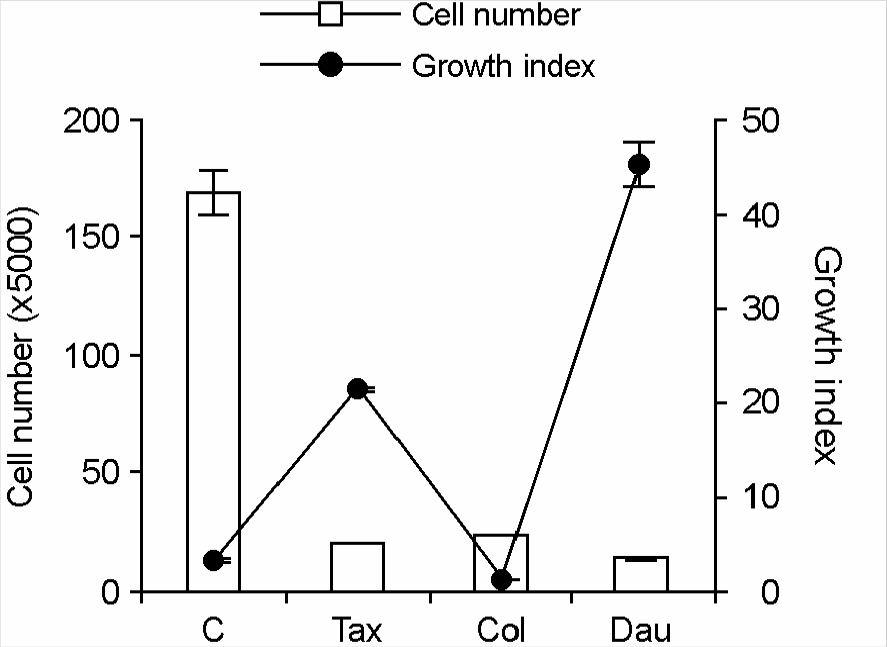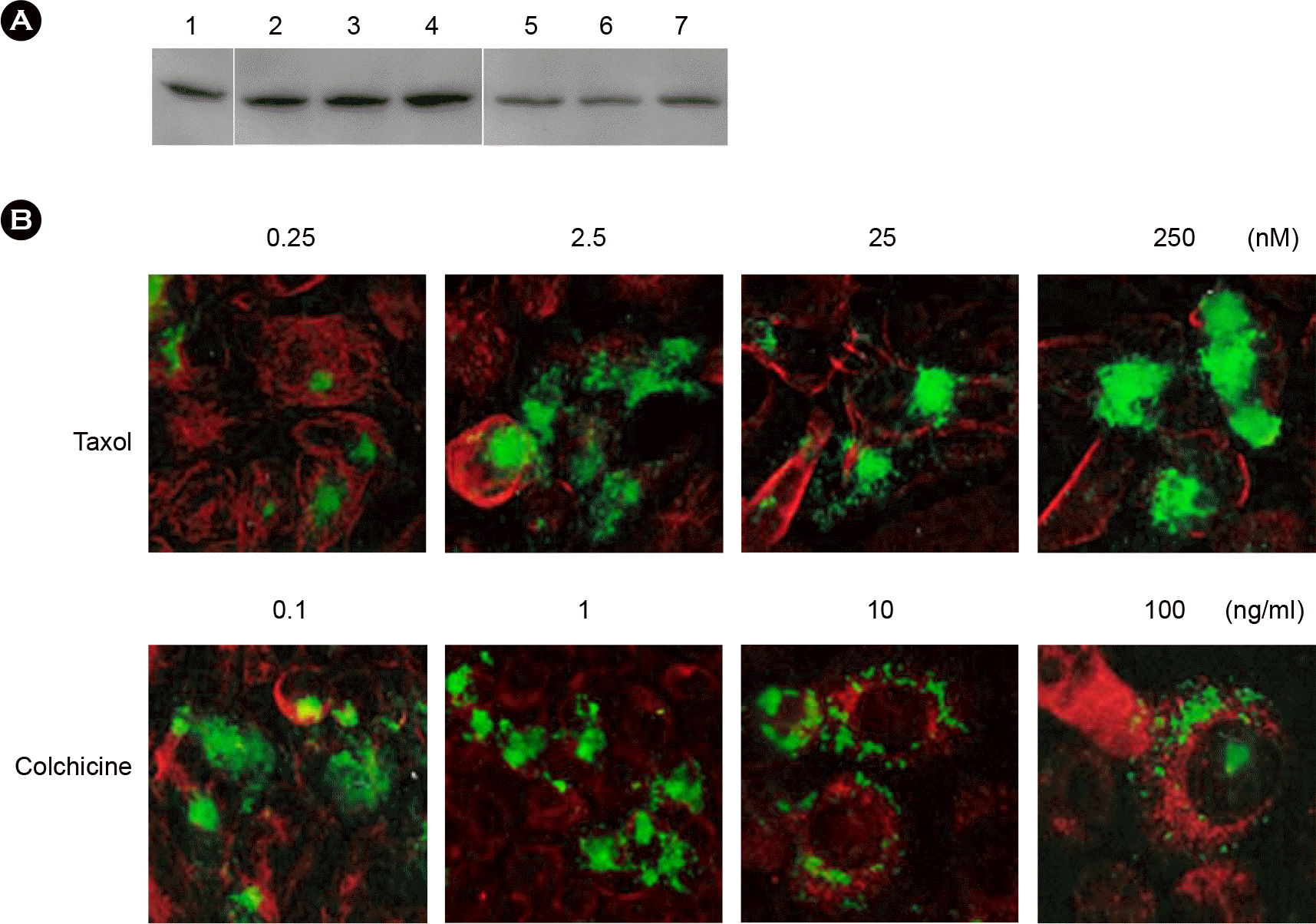Abstract
Microtubule network provides many intracellular microbes with an efficient way to move within host cells. Orientia tsutsugamushi move from the cell periphery to the microtubule organizing center (MTOC) by dynein-dependent mechanism. In this study, we investigated the role of microtubule on the growth of O. tsutsugamushi. The treatment of infected cells with taxol as well as daunomycin enhanced the bacterial growth in contrast to colchicine. Immunofluorescent (IF) staining of taxol-treated cells exhibited that O. tsutsugamushi clustered tightly near the nucleus with thick bundles of microtubules, whereas dispersed in the cytoplasm in colchicine-treated cells. These results suggest that microtubule network facilitate the growth of O. tsutsugamushi.
References
1). Amano K, Tamura A, Ohashi N, Urakami H, Kaya S, Fukushi K. Deficiency of peptidoglycan and lipopolysaccharide components in Rickettsia tsutsugamushi. Infect Immun. 55:2290–2292. 1987.
2). Chang WH, Kang JS, Lee WK, Choi MS, Lee JH. Serological classification by monoclonal antibodies of Rickettsia tsutsugamushi isolated in Korea. J Clin Microbiol. 28:685–688. 1990.
3). Clausen JD, Christiansen G, Holst HU, Birkelund S. Chlamydia trachomatis utilizes the host cell micro-tubule network during early events of infection. Mol Microbiol. 25:441–449. 1997.
4). Collot M, Louvard D, Singer SJ. Lysosomes are associated with microtubules and not with intermediate filaments in cultured fibroblasts. Proc Natl Acad Sci USA. 81:788–792. 1984.

5). Goetz M, Bubert A, Wang G, Chico-Calero I, Vazquez-Boland JA, Beck M, Slaghuis J, Szalay AA, Goebel W. Microinjection and growth of bacteria in the cytosol of mammalian host cells. Proc Natl Acad Sci USA. 98:12221–12226. 2001.

6). Hackstadt T, Rockey DD, Heinzen RA, Scidmore MA. Chlamydia trachomatis interrupts an exocytic pathway to acquire endogenously synthesized sphingomyelin in transit from the Golgi apparatus to the plasma membrane. EMBO J. 15:964–977. 1996.
7). Hackstadt T, Scidmore MA, Rockey DD. Lipid metabolism in Chlamydia trachomatis-infected cells: directed trafficking of Golgi-derived sphingolipids to the chlamydial inclusion. Proc Natl Acad Sci USA. 92:4877–4881. 1995.
8). Hanson B. Factors influencing Rickettsia tsutsugamushi infection of cultured cells. Am J Trop Med Hyg. 36:621–630. 1987.
9). Inn KS, Han SH, Kim HR, Huh MS, Seong SY, Kang JS, Han TH, Kim IS, Choi MS. Cellular invasion of Orientia tsutsugamushi requires initial interaction with cell surface heparan sulfate. Microb Pathog. 28:227–233. 2000.
10). Jeon KW. The large, free-living amoebae: wonderful cells for biological studies. J Eukaryot Microbiol. 42:1–7. 1995.

11). Kang JS Chang WH. Antigenic relationship among the eight prototype and new serotype strains of Orientia tsutsugamushi revealed by monoclonal antibodies. Microbiol Immunol. 43:229–234. 1999.
12). Kim MK, Kee SH, Cho KA, Chung MH, Lim BU, Chang WH, Kang JS. Apoptosis of endothelial cell line ECV304 persistently infected with Orientia tsutsugamushi. Microbiol Immunol. 43:751–757. 1999.
13). Kim MK, Odgerel Z, Chung MH, Lim BU, Kang JS. Characterization of monoclonal antibody reacting exclusively against intracellular Orientia tsutsugamushi. Microbiol Immunol. 46:733–740. 2002.
14). Kim SW, Ihn KS, Han SH, Seong SY, Kim IS, Choi MS. Microtubule and dynein-mediated movement of Orientia tsutsugamushi to the microtubule organizing center. Infect Immun. 69:494–500. 2001.
15). Meyer DH, Rose JE, Lippmann JE, Fives-Taylor PM. Microtubules are associated with intracellular movement and spread of the periodontopathogen Acti-nobacillus actinomycetemcomitans. Infect Immun. 67:6518–6525. 1999.
16). Molinari A, Calcabrini A, Crateri P, Arancia G. Effects of daunomycin on the microtubular network: a cytochemical study on a human melanoma cell line. Eur J Cell Biol. 54:291–298. 1991.
17). Moron CG, Popov VL, Feng HM, Wear D, Walker DH. Identification of the target cell of Orientia tsutsugamushi in human cases of scrub typhus. Mod Pathol. 14:752–759. 2001.
18). Na C, Timasheff SN. Physical-chemical study of daunomycin-tubulin interactions. Arch Biochem Biophys. 182:147–154. 1977.

19). Piperno G, LeDize M, Chang X. Microtubules containing acetylated α-tubulin in mammalian cells in culture. J Cell Biol. 104:289–302. 1987.
20). Rikihisa Y, Zhang Y, Park J. Inhibition of infection of macrophages with Ehrlichia risticii by cytochalasins, monodansylcadaverine, and taxol. Infect Immun. 62:5126–5132. 1994.
21). Seong SY, Choi MS, Kim IS. Orientia tsutsugamushi infection: overview and immune responses. Microbes Infect. 3:11–21. 2001.
22). Seong SY, Kim MK, Lee SM, Odgerel Z, Choi MS, Han TH, Kim IS, Kang JS, Lim BU. Neutralization epitopes on the antigenic domain II of the Orientia tsutsugamushi 56-kDa protein revealed by monoclonal antibodies. Vaccine. 19:2–9. 2000.
23). Schramm N, Wyrick PB. Cytoskeletal requirements in Chlamydia trachomatis infection of host cells. Infect Immun. 63:324–332. 1995.
24). Silverman DJ, Wisseman Jr CL. Comparative ultra-structural study on the cell envelopes of Rickettsia prowazekii, Rickettsia rickettsii, and Rickettsia tsutsugamushi. Infect Immun. 21:1020–1023. 1978.
25). Smirnova E, Shurland DL, Ryazantsev SN, van der Bliek AM. A human dynamin-related protein controls the distribution of mitochondria. J Cell Biol. 143:351–358. 1998.

26). Suikkanen S, Aaltonen T, Nevalainen M, Valilehto O, Lindholm L, Vuento M, Vihinen-Ranta M. Exploitation of microtubule cytoskeleton and dynein during parvoviral traffic toward the nucleus. J Virol. 77:10270–10279. 2003.

27). Tamura A. Invasion and intracellular growth of Rickettsia tsutsugamushi. Microbiol Sci. 5:228–232. 1988.
28). Tamura A, Ohashi N, Urakami H, Miyamura S. Classification of Rickettsia tsutsugamushi in a new genus, Orientia gen. nov., as Orientia tsutsugamushi comb. nov. Int J Syst Bacteriol. 45:589–591. 1995.
29). Tamura A, Urakami H. Easy method for infectivity titration of Rickettsia tsutsugamushi by infected cell counting. Jpn J Bacteriol. 36:783–785. 1981.
30). Terasaki M, Reese TS. Interactions among endopla smic reticulum, microtubules, and retrograde movements of the cell surface. Cell Motil Cytoskeleton. 29:291–300. 1994.
31). Thyberg J, Moskalewski S. Microtubules and the organization of the Golgi complex. Exp Cell Res. 159:1–16. 1985.

32). Urakami H, Tsuruhara T, Tamura A. Electron microscopic studies on intracellular multiplication of Rickettsia tsutsugamushi in L cells. Microbiol Immunol. 28:1191–1201. 1984.
33). Winkler HH. Rickettsia species (as organisms). Annu Rev Microbiol. 44:131–153. 1990.
Figure 1.
The effect of microtubule-modifying agents on the growth of O. tsutsugamushi. ECV304 cells were grown to subconfluence on 24-well culture plates. After infection, cells were incubated further for 3 days in the presence of 50 nM taxol (Tax), 10 ng/ml colchicine (Col), 40 ng/ml daunomycin (Dau) and without agent (C). The number of viable cells was counted using trypan blue exclusion assay. Growth index was calculated as described in Materials and Methods. Representative result of three independent experiments is shown.

Figure 2.
The stimulating effect of taxol on the growth of O. tsutsugamushi. (A) The infected cells treated with taxol or colchicine for 3 days were solubilized in lysis buffer. The lysates (25 μg) was separated on an 11% SDS-PAGE and was further analyzed with the immunoblot analysis using M686–8 for the estimation of bacterial growth. Lane 1, untreated control; lane 2, 2.5 nM taxol; lane 3, 25 nM taxol; lane 4, 100 nM taxol; lane 5, 5 ng/ml colchicine; lane 6, 10 ng/ml colchicine; lane 7, 100 ng/ml colchicine. (B) The cells treated with the indicated concentration of taxol or colchicine were stained using an anti-α-tubulin MAb and FS15 to stain tubulin and O. tsutsugamushi simultaneously. Magnification, ×200.

Figure 3.
Immunoblot analysis of acetylated tubulin after treatment of cells with chemicals. The infected cells treated with indicated chemicals were solubilized in lysis buffer. (A) 25 μg of lysate was separated on 11% SDS-PAGE and was analyzed with M686–8 for bacterial protein, anti-acetylated α-tubulin, and anti-β-actin. Lane 1, uninfected ECV304 cells; lane 2, infected cells without treatment; lane 3, 50 nM taxol; lane 4, 10 ng/ml colchicine; lane 5, 5 μM nocodazole; lane 6, 40 ng/ml daunomycin. (B) The density of each band was quantified using Quantaty One software and amount of acetylated tubulin was normalized with the density of β-actin.





 PDF
PDF ePub
ePub Citation
Citation Print
Print


 XML Download
XML Download